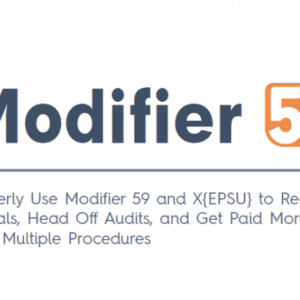If you’re using Modifier 59 to get paid for multiple procedures, auditors are watching you. Modifier 59 has been on the OIG’s (Office of the Inspector General) radar for a while now, and because of consistent misuse and abuse, it will likely stay that way.
Modifier 59 allows you to unbundle — separately report and get paid for — two or more procedures occurring during the same encounter by the same physician that would not normally be paid independently. Use modifier 59 correctly, and you’ll collect every penny of reimbursement for the work you do. But use it inaccurately, and the reimbursement you received for those claims most likely will be taken back. And if this leads to a full scale audit, you could face a Medicare fine of $10,000 for each time you billed modifier 59 incorrectly.
What’s the problem? You should use modifier 59 only when no other modifier is more appropriate. To know for sure whether modifier 59 is truly the best fit to describe a relationship between multiple procedures, you must — you guessed it — know how to use all the other modifiers. Luckily, most modifier 59 problems stem from confusion with five modifiers in particular:
- 25
- 50
- 51
- 76
- 91
Below, you’ll find a breakdown of those modifiers, along with tips and tricks for differentiating them from modifier 59.
**Tool: To help you report modifier 59 compliantly, enjoy 50% off Modifier 59 Expert Report. Use Mod59 at checkout for Printed Hard Copy only. Limited quantities.**
Modifier 59 Indicates a Distinct Procedural Service
Simply put, modifier 59 allows you to identify procedures that aren’t normally reported together for billing purposes. Modifier 59 informs your carrier that you performed a distinct and independent service from another non-E/M service or procedure performed on the same day. Your documentation must support services that are not ordinarily encountered or performed on the same day by the same individual. To qualify for modifier 59, you must be able to document:
- different session
- different procedure or surgery
- different site or organ system
- separate incision/excision
- separate lesion, or separate injury (or area of injury in extensive injuries)
How can you figure out when you can appropriately apply modifier 59 to unbundle a code pair and qualify for payment? The first thing you need to do is rule out all of the other modifiers. CMS states that “only if no more descriptive modifier is available, and the use of modifier 59 best explains the circumstances, should modifier 59 be used.” Many of those modifiers will be easy to rule out, but the following five are trickier.
Modifier 25: For E/M Codes Only
Statistics suggest that modifier 25 is misused nearly 50 percent of the time. A lot of confusion arises between these two modifiers because they both deal with different services by the same provider on the same day. But look carefully at the definitions for each modifier, and you’ll see an important difference:
Modifier 25 indicates a significant, separately identifiable evaluation and management service by the same physician or other qualified health care professional on the same day of the procedure or other service.
The simplest way to avoid confusion between modifiers 59 vs 25 is to remember that you should use 25 only with E/M codes, whereas you should never append 59 to E/M services.
Use modifier 25 when an E/M service is significant and separately identifiable from a procedure or other service that was done by the same provider on the same day. It signifies that the E/M services being submitted for payment went above and beyond that usually associated with a surgical procedure or another E/M service (such as a preventive medicine visit) and should be compensated separately.
Example: A patient presents for a scheduled Synvisc-One® injection into her right knee. Just before the injection, she complains of a sore wrist. The physician administering her knee injection also provides the separate service of evaluating her wrist during her office visit. Using modifier 59 is incorrect in this case because your doctor’s examination of the wrist is considered an E/M code. Modifier 25 is the correct choice appended to the office visit code such as CPT codes 99212-99215.
Modifier 50: Same Site, Different Side
The main confusion between modifiers 50 and 59 seems to be that both have the word “same” in their descriptors:
- Modifier 50 is for the “same session”
- Modifier 59 for the “same day” and the “same individual.”
Modifier 50 is used to report bilateral procedures that are performed at the same operative session by the same physician. Bilateral means that the same procedure is done on the same body part on both the left and right sides of the body.
Example 1: A patient has osteoarthritis of both knees and undergoes bilateral knee injections (20610). The second injection would be correctly coded by appending modifier 50 to indicate the services provided were bilateral (on both knees).
Tip: Depending on your carriers, you may need to bill with right (RT) and left (LT) modifiers, or a quantity of two instead of modifier 50.
Example 2: A patient has multi-joint osteoarthritis and undergoes injections in the right knee joint and also in the left hip joint. Because the clinician administers the injections in different joints, the services are not considered bilateral. Modifier 59 is the correct modifier to apply.
Modifier 51: Same Session, Multiple Procedures
Modifiers 51 and 59 have some very distinct differences, but there are three key similarities that consistently lead to the misuse of each:
- More than one procedure performed
- Neither modifier should be used with E/Mservices
- Both are to report services performed on the same day for the same patient
Use modifier 51 when multiple procedures, other than E/M services, Physical Medicine and Rehabilitation services or provision of supplies (e.g., vaccines) are performed at the same session by the same individual. Identifying when your provider performs a procedure during the “same session” versus a “different session” will help you better understand when you should apply each modifier.
Example 1: An established patient presents with lesions on his chest and hand. Your dermatologist removes the lesions. The sites are different, but the lesions are removed during one session, making modifier 51 the most appropriate.
Example 2: Your family practitioner removes a skin tag from an established patient in the morning. The same patient returns to your office in the afternoon of the same day, and the same physician treats the patient for a broken right great toe due to the patient falling down some stairs. Using Modifier 51 here would be an error because this is a different session, even though it is the same day. Modifier 59 is the correct choice.
Modifier 76: Same Procedure, Different Day
Modifier 76 indicates a repeat procedure or service by the same physician or other qualified health care professional, subsequent to the original services. Again, modifiers 76 and 59 have similarities that make them easy to confuse:
- They both describe services provided by the same physician
- They are both used to report multiple procedures
- They both should never be used with E/M services.
The word in the definition that best describes the difference between these two modifiers is “subsequent.” The key to using these modifiers correctly is to understand that modifier 76 reports a repeated service or procedure by the same practitioner subsequent to the original service or procedure. But to correctly use modifier 59, the provider must always perform the services on the same day.
Example: Your physician performs a radiologic examination of the chest, and subsequently (on another day) takes the same images again. Because the images were not coded on the same day, you should submit them with modifier 76 on the subsequent procedure. If the repeat procedure had occurred later on the same day, modifier 59 would be correct.
Modifier 91: Same Test, Same Day
Any modifier involving multiple procedures on the same day by the same practitioner seems to be at risk of being confused with modifier 59. That’s also the story with modifier 91. Again, it’s the word “same” that seems to be confusing. The correct use of modifier 91 is to indicate repeat laboratory tests or studies that are performed on the same day for the same patient — not procedures or other services.
Example: A patient had a dose of theophylline in the morning for her asthma, followed by a theophylline test. The same patient came back in the afternoon for another theophylline test to check for absorption levels of the drug. In this case, modifier 91 is correct because the exact same lab test was performed on the same patient during the same day.
Learning to use modifier 59 compliantly will reduce your denials rate and keep your practice off auditors’ radar. To understand the difference between modifier 59 and it’s commonly confused counterparts, you must pay attention to key words in each modifier’s definition. As always, the rules for each modifier may vary depending on your carrier, so if you’re sure you’re using a modifier correctly but still getting denials, check with the carrier. The lesson here is to slow down and really read the modifier definitions. Although each modifier has word similarities with modifier 59, their meanings couldn’t be more different.
Commonly Viewed Modifier 59 Training Resources



